#ottheinrich-bibel
Text

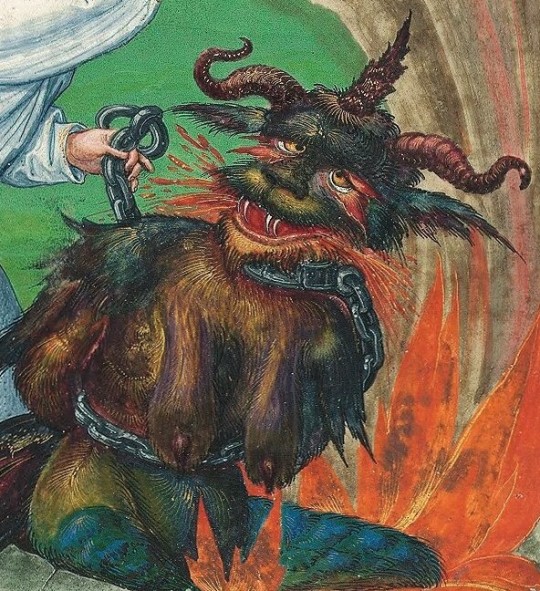
demon being punished by an angel
in the "ottheinrich-bibel", vol. 8, illuminated in 1530 by mathis gerung
source: Munich, Bayerische Staatsbibliothek, Cgm 8010(8, fol. 303 verso [detail].
#illumination#illuminated manuscripts#demon#angel#miniature#renaissance#ottheinrich-bibel#mathis gerung#matthias gerung
2K notes
·
View notes
Photo

The Great Whore of Babylon mother of prostitutes and of all the abominations of the earth, sitting proud and defiant against God on her pet of Seven Heads, raises to your health her "golden cup full of the filthiness of her fornication" (Rev 17:4-5)
Ottheinrich-Bibel. Matthias Gerung ~ ca.1430 Bayerische Staatsbibliothek • via Bibliothèque Infernale on FB
1K notes
·
View notes
Text
Eschatological Conspiratorialism
I wrote a little bit about eschatological conspiratorialism: or, seriously, wtf qanon
What is crucial is less why someone believes than what that belief allows them to do

Matthias Gerung (1500–1570), Ottheinrich-Bibel, Bayerische Staatsbibliothek, The Fifth and Sixth Trumpets, Revelation 9:1-12 (pg. 292)
Ask a nonbeliever to describe the QAnon conspiracy theory, and they almost immediately reach for metaphors of madness: batshit insane, fucking crazy, bonkers, etc. Bracketing…
View On WordPress
1 note
·
View note
Photo

St. Peter Healing a Crippled Beggar (p. 228v from the Ottheinrich-Bibel), Matthias Gerung, ca. 1530-32
#art#art history#Matthias Gerung#Northern Renaissance#German Renaissance#illuminated manuscript#illustration#Saint Peter#religious art#Biblical art#Christian art#New Testament#Book of Acts#German art#16th century art#Bayerische Staatsbibliothek
41 notes
·
View notes
Photo
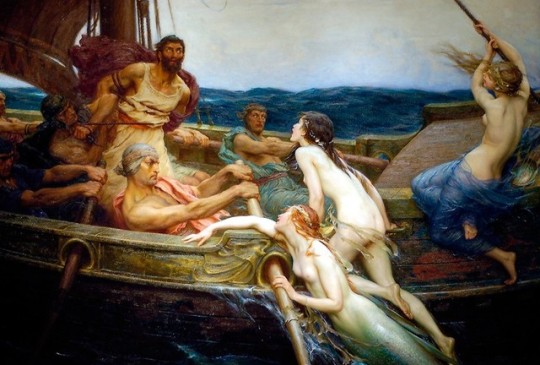

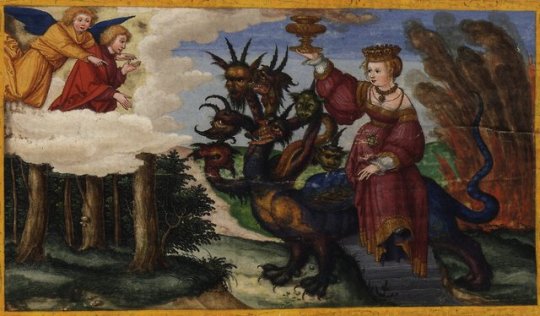
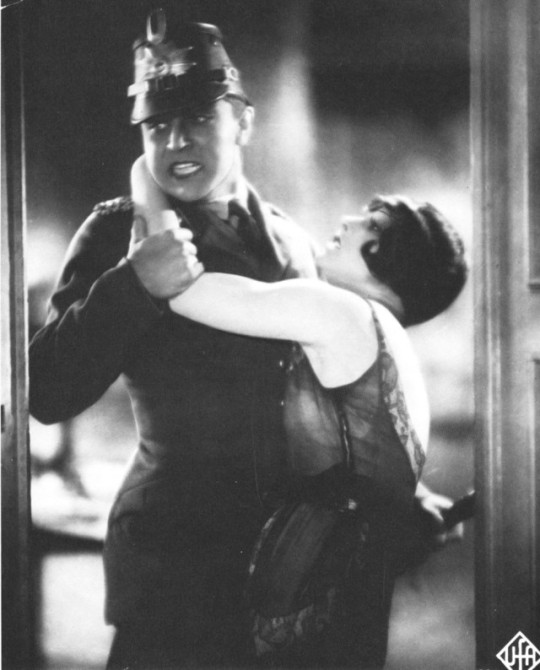
FEMME FATALE
Wikipedia’s definition of the femme fatale:
A femme fatale (/ˌfæm fəˈtɑːl/ or /ˌfɛm fəˈtɑːl/; French: [fam fatal]), sometimes called a maneater or vamp, is a stock character of a mysterious and seductive woman whose charms ensnare her lovers, often leading them into compromising, dangerous, and deadly situations. She is an archetype of literature and art. Her ability to enchant and hypnotise her victim with a spell was in the earliest stories seen as being literally supernatural; hence, the femme fatale today is still often described as having a power akin to an enchantress, seductress, vampire, witch, or demon, having power over men. In American early 20th century film, femme fatale characters were referred to as vamps, an allusion to their role as sexual vampires. Many female mobsters (especially members of the Italian-American Mafia or Russian Mafia) have been known to be femme fatales in many film noirs as well as James Bond films.
One of the most common traits of the femme fatale includes promiscuity and the "rejection of motherhood", seen as "one of her most threatening qualities since by denying his immortality and his posterity it leads to the ultimate destruction of the male". Femmes fatales are typically villainous, or at least morally ambiguous, and always associated with a sense of mystification, and unease.
https://en.wikipedia.org/wiki/Femme_fatale
4 notes
·
View notes
Text
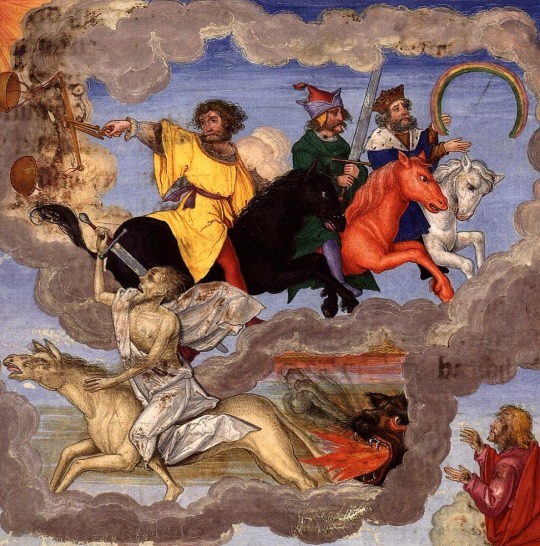
Pestilencia, Guerra, Hambre, Muerte: los Cuatro Jinetes del Apocalipsis llegan a la ciudad. Matthias Gerung ~ hacia 1530 Ottheinrich-Bibel, Bayerische Staatsbibliothek
0 notes
Text
Thursday: Preparation for the Fifth Sunday in Lent
Hebrew Scripture from the Latter Prophets: Ezekiel 1:1-3; 2:8–3:3
In the thirtieth year, in the fourth month, on the fifth day of the month, as I was among the exiles by the river Chebar, the heavens were opened, and I saw visions of God. On the fifth day of the month (it was the fifth year of the exile of King Jehoiachin), the word of the Lord came to the priest Ezekiel son of Buzi, in the land of the Chaldeans by the river Chebar; and the hand of the Lord was on him there.
But you, mortal, hear what I say to you; do not be rebellious like that rebellious house; open your mouth and eat what I give you. I looked, and a hand was stretched out to me, and a written scroll was in it. He spread it before me; it had writing on the front and on the back, and written on it were words of lamentation and mourning and woe.
He said to me, O mortal, eat what is offered to you; eat this scroll, and go, speak to the house of Israel. So I opened my mouth, and he gave me the scroll to eat. He said to me, Mortal, eat this scroll that I give you and fill your stomach with it. Then I ate it; and in my mouth it was as sweet as honey.
Psalm 130
Out of the depths I cry to you, O Lord.
Lord, hear my voice!
Let your ears be attentive
to the voice of my supplications!
If you, O Lord, should mark iniquities,
Lord, who could stand?
But there is forgiveness with you,
so that you may be revered.
I wait for the Lord, my soul waits,
and in his word I hope;
my soul waits for the Lord
more than those who watch for the morning,
more than those who watch for the morning.
O Israel, hope in the Lord!
For with the Lord there is steadfast love,
and with him is great power to redeem.
It is he who will redeem Israel
from all its iniquities.
New Testament Lesson: Revelation 10
And I saw another mighty angel coming down from heaven, wrapped in a cloud, with a rainbow over his head; his face was like the sun, and his legs like pillars of fire. He held a little scroll open in his hand. Setting his right foot on the sea and his left foot on the land, he gave a great shout, like a lion roaring. And when he shouted, the seven thunders sounded. And when the seven thunders had sounded, I was about to write, but I heard a voice from heaven saying, “Seal up what the seven thunders have said, and do not write it down.” Then the angel whom I saw standing on the sea and the land
raised his right hand to heaven
and swore by him who lives forever and ever,
who created heaven and what is in it, the earth and what is in it, and the sea and what is in it: “There will be no more delay, but in the days when the seventh angel is to blow his trumpet, the mystery of God will be fulfilled, as he announced to his servants the prophets.”
Then the voice that I had heard from heaven spoke to me again, saying, “Go, take the scroll that is open in the hand of the angel who is standing on the sea and on the land.” So I went to the angel and told him to give me the little scroll; and he said to me, “Take it, and eat; it will be bitter to your stomach, but sweet as honey in your mouth.¹” So I took the little scroll from the hand of the angel and ate it; it was sweet as honey in my mouth, but when I had eaten it, my stomach was made bitter.
Then they said to me, “You must prophesy again about many peoples and nations and languages and kings.”
Year A Lent 5 Thursday
Selections are from Revised Common Lectionary Daily Readings copyright © 1995 by the Consultation on Common Texts.
Unless otherwise indicated, Bible text is from New Revised Standard Version Bible (NRSV) copyright © 1989 by the Division of Christian Education of the National Council of Churches of Christ in the United States of America. Used by permission. All rights reserved.
Image credit: A Mighty Angel by Matthias Gerung Ottheinrich-Bibel, Folio 293r, via Wikimedia Commons. This is a public domain image.
0 notes
Text
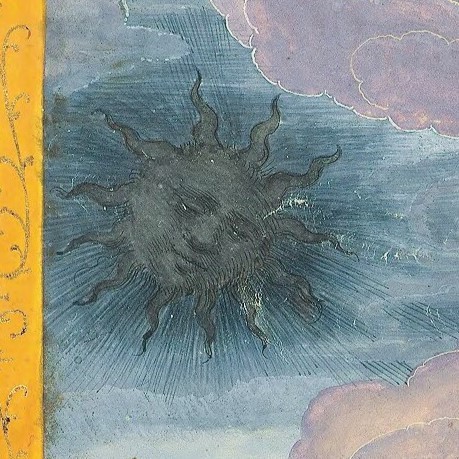

black sun & red moon
"I watched as he opened the sixth seal. There was a great earthquake. The sun turned black like sackcloth made of goat hair, the whole moon turned blood red, and the stars in the sky fell to earth, as figs drop from a fig tree when shaken by a strong wind."
– Revelation 6,12-13 (NIV)
details from the "ottheinrich bible" (vol. 8), bavaria, c. 1430, illuminated in 1530-31 by matthias gerung
source: Munich, BSB, Cgm 8010(8, fol. 289r
#15th century#16th century#matthias gerung#ottheinrich bible#ottheinrich-bibel#apocalyse#sun#moon#sixth seal
350 notes
·
View notes
Text

the beheading of john the baptist
in the 'ottheinrich bible', vol. 2, germany, ca. 1430
source: Munich, BSB, Cgm 8010(2, fol. 53r (detail)
#medieval art#15th century#john the baptist#beheading#illuminated manuscript#ottheinrich bible#ottheinrich-bibel#cw gore#christian iconography
66 notes
·
View notes
Text

fashionable angel
in the "ottheinrich-bibel", vol. 8, illuminated in 1530 by mathis gerung
source: Munich, Bayerische Staatsbibliothek, Cgm 8010(8, fol. 293 recto [detail].
#illumination#illustration#illuminated manuscript#angel#fashion#16th century#manuscript#ottheinrich bibel#renaissance art
374 notes
·
View notes
Text


the seven-headed beast of the apocalypse
in the "ottheinrich bible", bavaria, illuminated in 1530 by matthias gerung
source: Munich, BSB, Cgm 8010(8, fol. 295r
#ottheinrich bibel#apocalypse#illumination#renaissance art#illuminated manuscript#illustrated manuscript#16th century#mathis gerung#seven-headed beast#dragon
244 notes
·
View notes
Photo
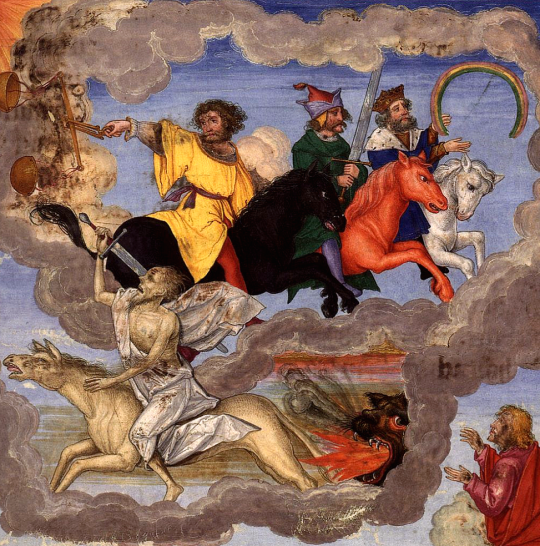
Pestilence, War, Famine, Death: the Four Horsemen of the Apocalypse come to town. Matthias Gerung ~ ca.1530 Ottheinrich-Bibel, Bayerische Staatsbibliothek • via Bibliothèque Infernale on FB
70 notes
·
View notes
Photo

Apokalypse, Ottheinrich-Bibel. Matthias Gerung ~ ca.1530 Bayerische Staatsbibliothek • via Bibliothèque Infernale on FB
107 notes
·
View notes
Photo

The Whore of Babylon and her favourite mate, the Beast with Seven Heads and Ten Horns. Matthias Gerung ~ ca.1530 Ottheinrich-Bibel, BSB • via Bibliothèque Infernale on FB
294 notes
·
View notes
Photo
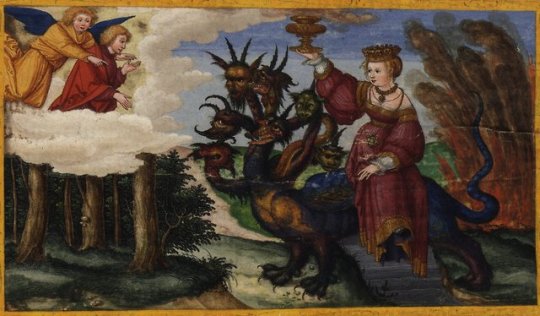
DIE HURE BABYLON
Auszug aus Die Hure Babylon von Richard Herzinger (Artikel erschien am 24.9.2001 in der NZZ)
Der Ort aber, an dem die Zivilisation lebendige Form annimmt, ist die Stadt. Dort treffen Fremde unterschiedlicher Abstammung aufeinander und müssen kulturelle Regelwerke schaffen, die von allen respektiert werden können. Aus den komplexen, arbeitsteiligen Beziehungen, die hier entstehen, entwickelt sich der Markt und die Geldwirtschaft. In allen Kulturen ist die Stadt Kern und Motor zivilisatorischer Entwicklung – gerade darum aber steht sie von Anfang an auch unter einem Generalverdacht. Ist ihre Existenz nicht ein unerhörter Bruch mit der natürlich vorbestimmten Lebensweise der Menschen? Reisst sie ihn nicht aus der symbiotischen Einheit der Gemeinschaft mit ihrem angestammten Boden, ist Haltlosigkeit und Ausschweifung nicht die unausweichliche Folge dieser Entwurzelung? Kurz, ist sie nicht Ausdruck und Nährboden einer ungeheuren Hybris, einer gotteslästerlichen Auflehnung gegen die ursprüngliche und ewige Ordnung der Welt? In der jüdisch-christlichen Überlieferung erscheint die Gründung der ersten Stadt gar als indirekte Folge des Verbrechens. Kain, der Brudermörder, wird von Gott dazu verurteilt, «unstet und flüchtig» durch die Welt zu ziehen; so wird er zum ersten Nomaden und schliesslich zum Stadtgründer.
Aus den Städten entwickeln sich Metropolen und schliesslich jene «Riesenstädte» der Hochzivilisation, die Oswald Spengler in seinem «Untergang des Abendlandes» bezichtigte, sie saugten dem umliegenden Land seine natürliche Lebenskraft aus. Die grosse Stadt ist schon von alters her die bevorzugte Zielscheibe apokalyptischer Untergangsphantasien. Sodom und Gomorrha übereignet Gott wegen ihrer Ausschweifungen dem Feuertod. Das biblische Urbild der sündigen Stadt ist aber Babylon, das sein Selbstbewusstsein durch den Bau eines Turms manifestiert, «dessen Spitze bis an den Himmel reiche». Von dieser Demonstration menschlichen Erfindungsgeistes sah sich der Herr in seiner Autorität bedroht, weswegen er die Sprache der Babylonier verwirrte und sie in alle Länder zerstreute, so «dass sie aufhören mussten, die Stadt zu bauen».
Die Apokalyptik prophezeit ein bevorstehendes, endzeitliches göttliches Strafgericht, in dessen Verlauf die Toten auferstehen, die Ungerechten zu Höllenqualen verurteilt und die Gerechten zur Seligkeit erhöht werden. Mit der Offenbarung des Johannes im Neuen Testament beginnt die Instrumentalisierung apokalyptischer Phantasien für realgeschichtliche Zwecke. Mit der «grossen Hure» Babylon, deren Lasterhaftigkeit Johannes in grellsten Farben brandmarkt und deren Vernichtung dem Anbruch des Reichs Gottes vorangehen soll, ist eigentlich Rom gemeint, das Herz des heidnischen Imperiums, von dem die Welt befreit werden müsse.
Bild: Die Hure Babylon in der Ottheinrich-Bibel (um 1530–1532)
0 notes
Photo



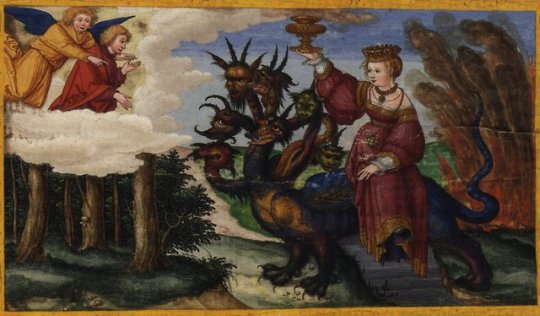
DIE STADT ALS FEMME FATALE UND HURE BABYLON
Auszug aus Weiblichkeit und Metropole, Konstruktionen von Raum und Geschlecht im Film der Weimarer Zeit und im Nationalsozialismus von Eva Warth (Erschienen im Sammelband Stadt - Raum - Geschlecht, 2000)
GROSSSTADTPHANTASMEN
Doch zunächst einige Anmerkungen zu den kulturellen Diskursen und Phantasien, in denen Assoziationen des Urbanen mit dem Weiblichen festgeschrieben werden. In ihrer kulturhistorischen Untersuchung zur Genealogie der Verbindung von Stadt und Frau, die von antiken Gründungsmythen bis zu literarischen Stadtbeschreibungen im 20. Jahrhundert reicht, zeigt Sigrid Wiegel auf, dass frühere Stadtbeschreibungen ein gespaltenes Frauenbild instrumentalisierten, bei dem die “unbegrenzte, unbewältigte Natur (...) mit dem wilden Anteil des Weiblichen, das begrenzte zivilisierte und eroberte Territorium - z.B. die Stadt - mit seinem domestizierten Anteil verglichen wurde”. Jedoch kehrt beim “Übergang von der Stadt zur Gross-Stadt dieser wilde Anteil wieder ins Innere der Stadt zurück”. In Anlehnung an Walter Benjamin nennt Wiegel das Wuchern der Grossstadt, ihre uneindeutige Begrenzung, die Vielfalt von Zentren und ihre labyrinthische Struktur urbane Phänomene, welche die Assoziation mit einer undomestizierten Weiblichkeit nahelegen: “Gerade jene Momente der Stadt, die als uneindeutig und unbewältigt betrachtet werden, erhalten eine weibliche Zuschreiben. Die Stadt als Versprechen der Selbstfindung, als Ort der Verführung und des drohenden Selbstverlustes wird mit dem Weiblichen analogisiert.”
Die Zuordnung von Stadt und Frau, die sich im bekannten Bild der Stadt als “Hure Babylon” festschreibt, verdichtet sich durch zwei weitere Konnotationsmuster, die in die Konzeption der Grossstadt einfliessen und die Metapher der lockenden Verführerin durch das Bild der bedrohlichen und zerstörerischen Frau ergänzen. Dies ist erstens die sich im späten 19. Jahrhundert - vor allem in Le Bons Studie “Psychologie der Massen” - abzeichnende Tendenz, die Masse mit der Vorstellung einer exzessiven, bedrohlichen Weiblichkeit in Verbindung zu bringen. Andreas Huyssen beschreibt dieses Phänomen wie folgt: “The fear of the masses in this age of declining liberalism is always also a fear of woman, a fear of nature out of control, a fear of the unconscious, of sexualis, of the loss of identity and stable ego boundaries in the mass. (...) Male fears of an engulfing femininity are here projected onto the metropolitan masses.”
Wenn in der modernen Grossstadt der wilde Anteil der Weiblichkeit ins Innere der Stadt zurückkehrt, wie Sigrid Wiegel sagt, so ist dies zweitens auf das Konzept der Grossstadt als gigantische Maschinerie zurückzuführen. Im Grossstadt Diskurs verbindet sich dieses Bild vom urbanen Getriebe mit einer im 19. Jahrhundert entwickelten weiblichen Maschinenmetaphorik, deren Ursprung Huyssen folgendermassen charakterisiert: “As soon as the machine came to be perceived as a demonic, inexplicable threat and as harbinger of chaos and destruction (...) weiteres began to imagine the Maschinenmensch as woman. (...) The fears and perceptual anxieties emanating from ever more powerful machines are recast and reconstructed in terms of the male fear of female sexuality.”
0 notes